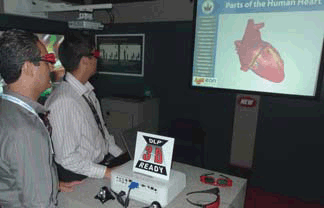- At this year’s InfoComm, a number of technical innovations in video projection are coming from the Texas Instruments’ DLP side. Three important new projection applications/ technologies are moving from lab to boardroom and classroom fast, and include lampless projection, single-projector 3D and ultra-short throw projection.
- Texas Instruments has been showing prototypes of LED-based DLP projectors at trade shows, but this week in Orlando these projectors have taken a quantum leap forward.
- At the TI/DLP booth 5141, TI is showing a LED light source projector with a Luminus LED “light engine.” This unit is significantly brighter
Attendees at the Mitsubishi booth (4741) get a demo of single-projector 3D. Mitsubishi is one of six exhibitors showing new-generation, lowpriced DLP projectors that are 3D-ready. than any LED-based projector shown before. (While nominally about 1200 lumens, it “reads” much brighter than that, with an enhanced “perceived brightness that is not hype but the result of a larger color space, and the subject of a recent study presented at SID claiming that this brightness premium is real, not just psychological.)
Showing a market-ready lamp-free projector at InfoComm is that perennial DLP innovator, projectiondesign (Booth 3761) of Norway. Check out its booth to see an approximately 700-lumen LED-based DLP projector.
But probably the most interesting new application is one that has jumped from the consumer side to the commercial AV side of the fence: 3D, using just one projector. Biggun 3D-ready projectors have been available from other manufacturers for the past couple years, but new at this year’s Show are new, affordable 120 Hz time-sequential 3D-compatible projectors that will ship later this year from various manufacturers in the DLP camp: BenQ, Mitsubishi, Optoma, Sharp, Viewsonic and Infocus with an update of a unit previously released.
The MP772 ST projector from BenQ’s (Booth 4417) displays both 2D and 3D content, at 2500 ANSI lumens and XGA resolution.
The Mitsubishi (Booth 4741) XD600U is the first projector in Mitsubishi’s line designed with the latest DLP DDP2230 and “DLP Link” chipset, making it 3D-ready. The XGA-resolution projector is 4500 lumens.
Sharp (Booth 4701) is showing a prototype BrilliantColor 3-D DLP model. Using 3D shutter glasses with 120 Hz refresh rate for flicker-free images, the projector is designed to offer compatibility with both 3D and 2D content.
All of these 3D-ready projectors are “3Dready” because Texas Instruments has begun offering a firmware upgrade to its customers that enables 120 Hz, 60 Hz full-res image to each eye. Hence, DLP projector manufacturers are coming to market with products that are competitive in the education market in particular, as 3D has many applications in instruction.
Key to being 3D-ready is TI’s “DLP Link,” a new system that syncs—using a photo diode in the glasses that are reading the screen—the stereo switching to the content (instead of using an IR emitter to achieve this). This is now possible with DLP because 120Hz is fast enough that you can take down time in the processing and use that extra speed, or bandwidth, to put in an extra layer to communicate back to the glasses with the sync signal. And for the education market, shutter glasses are now readily available from a variety of makers such as XpanD or in a bundled deal from RealD.










